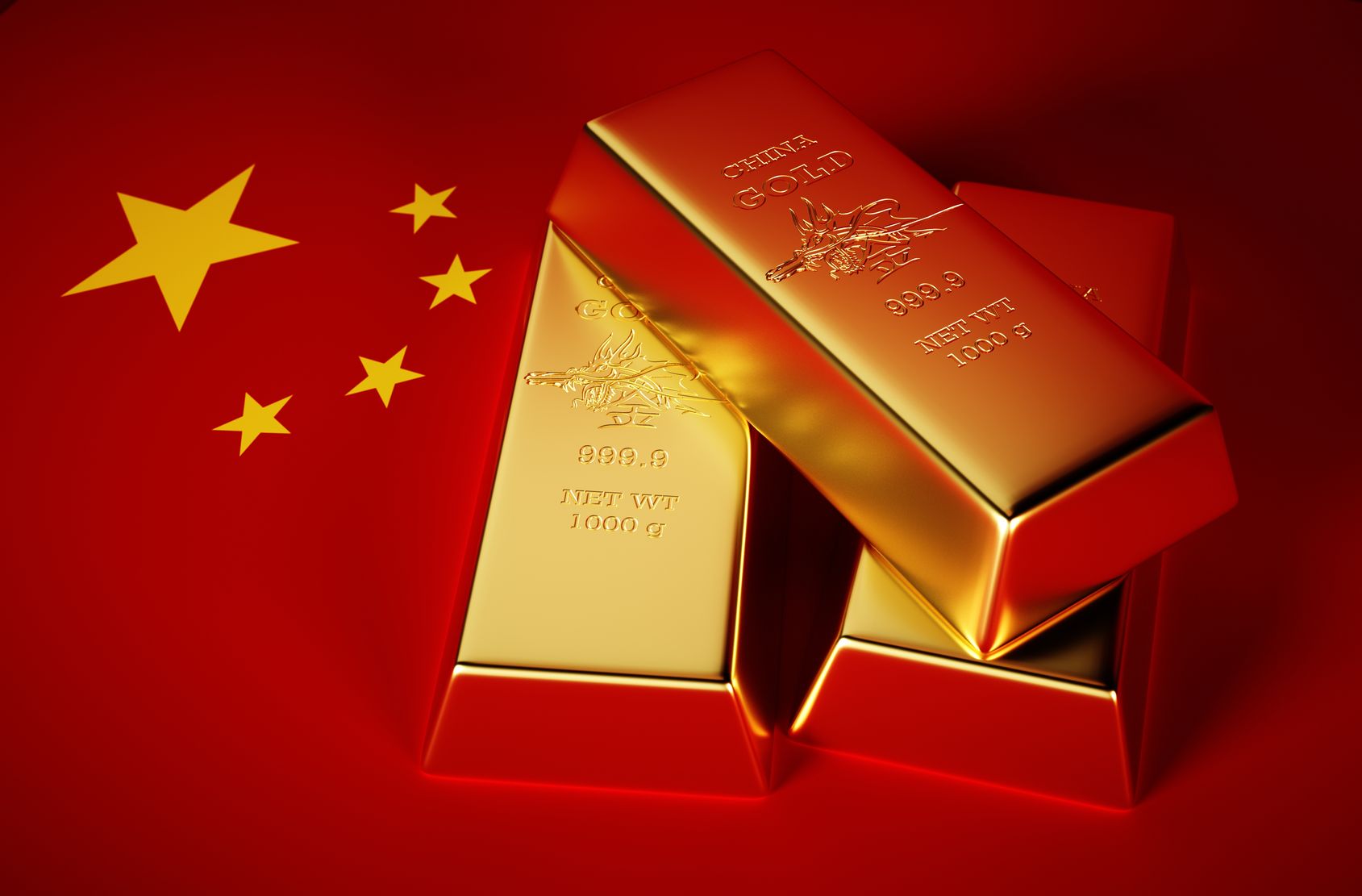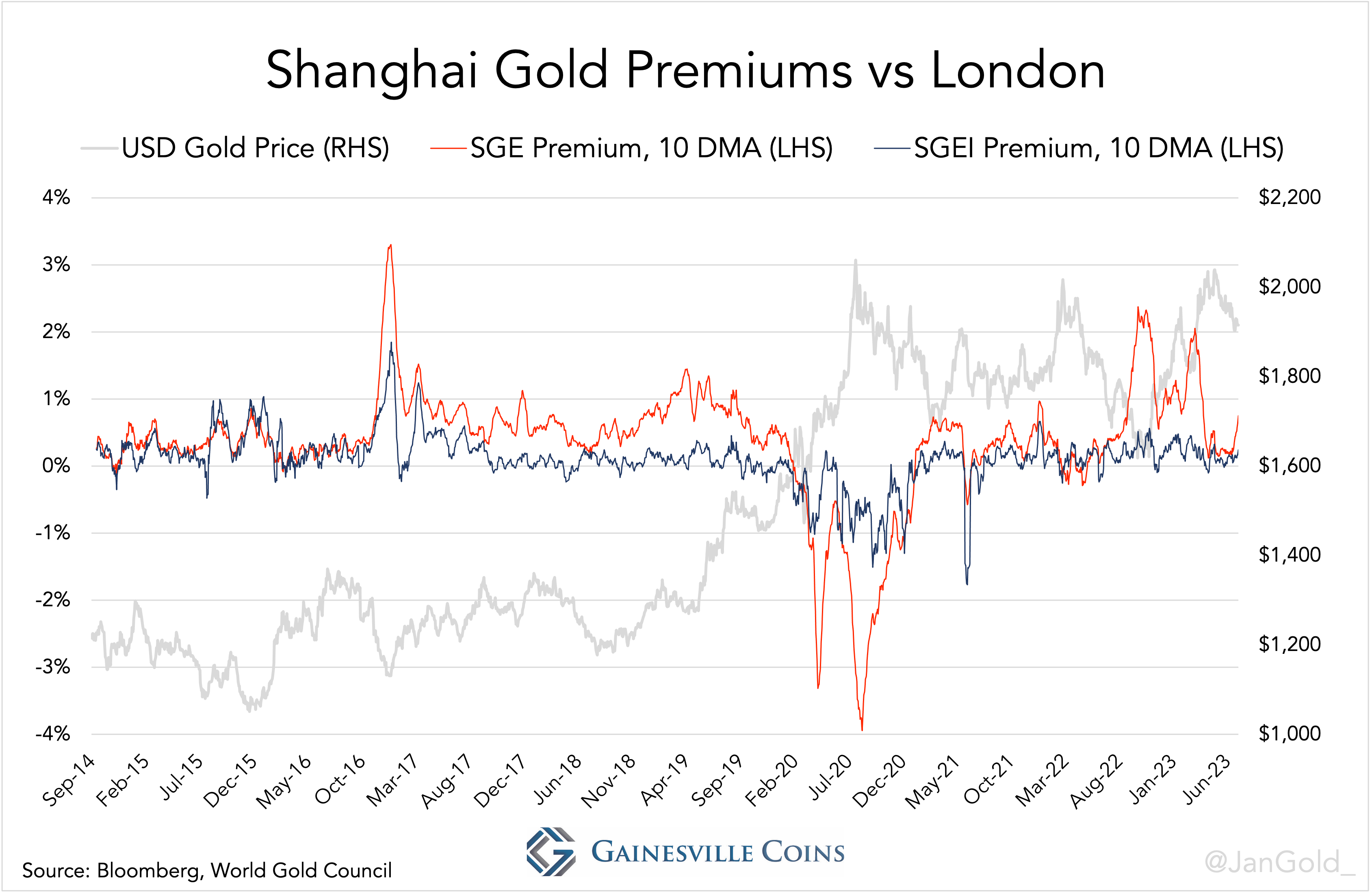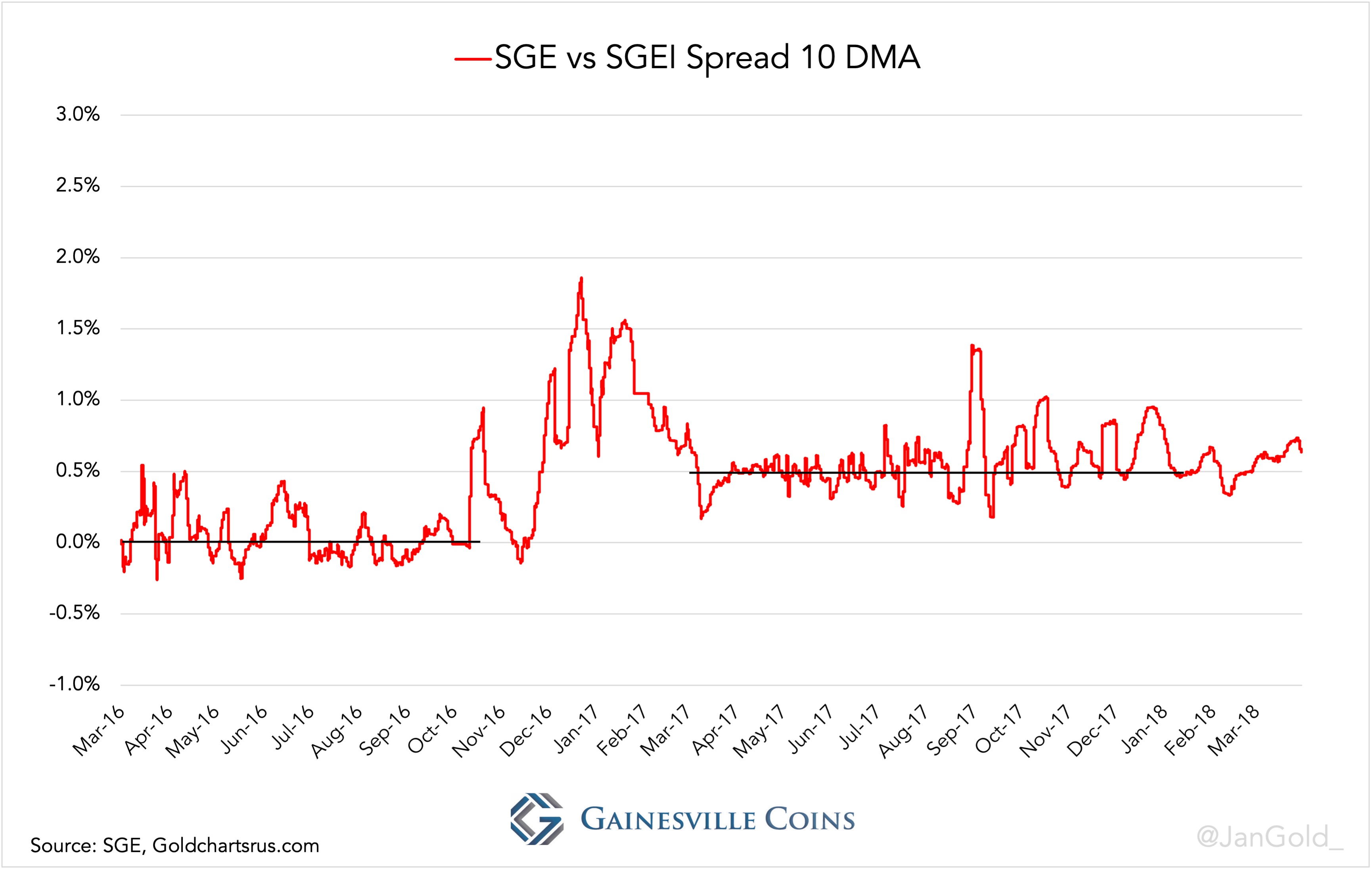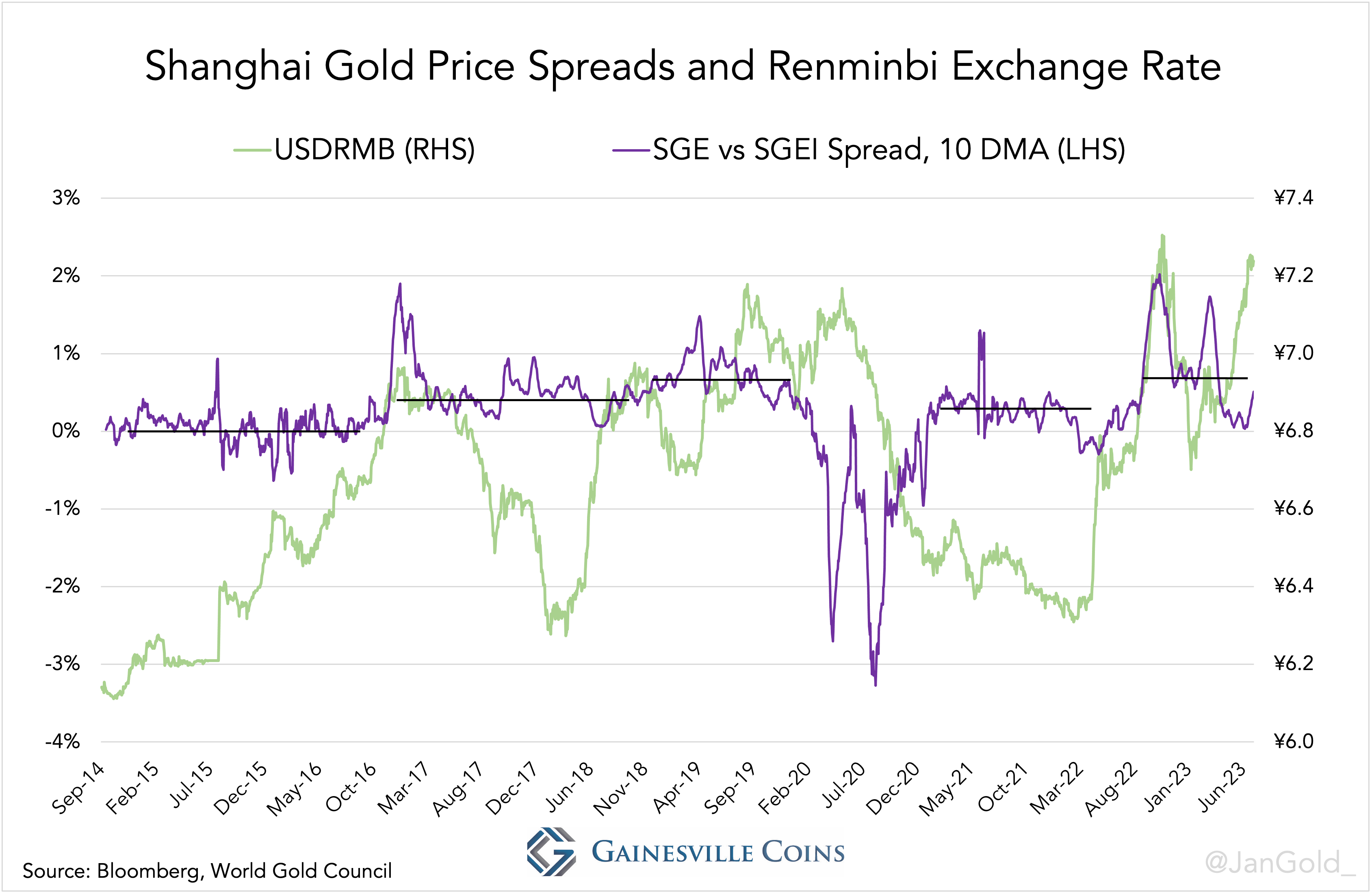by Jan Nieuwenhuijs, Gainesville Coins:

By obstructing gold import and export the People’s Bank of China (PBoC) greatly amplifies the gold premium or discount on the Shanghai Gold Exchange (SGE) relative to metal traded in London. In the past 12 months the PBoC has restricted gold import to curb capital flight and defend the renminbi, resulting in exaggerated SGE premiums. With these interventions the Chinese central bank risks the gold market it supervises from functioning properly, and stagnates internationalization.
TRUTH LIVES on at https://sgtreport.tv/
 The difference between the gold price on the Shanghai Gold Exchange (SGE) and Shanghai International Gold Exchange (SGEI) reveals manipulation on the part of the central bank.
The difference between the gold price on the Shanghai Gold Exchange (SGE) and Shanghai International Gold Exchange (SGEI) reveals manipulation on the part of the central bank.
Introduction
The core responsibilities of the PBoC are to “maintain financial stability … and to maintain the stability of the value of the currency and thereby promote economic growth.” To this end it wants to strengthen China’s economic security by letting the population accumulate gold (source: page 27). Additionally, the Chinese central bank uses capital controls to manage the renminbi’s exchange rate. A dilemma arises, for example, when Chinese people rush to buy gold as a form of capital flight, which undesirably weakens the renminbi.
Since 2016, there have been several periods in which the PBoC restricted gold imports into the Chinese domestic market to stem capital flight, lifting SGE premiums over the international benchmark (London spot). Remarkably, when there is no capital flight, and China is a net gold importer, the PBoC seems to aim at a 0.5% floor for SGE premiums.
Gold export from the domestic market is more or less prohibited by the PBoC. As a consequence, when the Chinese turn into net sellers, as happened in 2020, gold on the SGE trades at a steep discount versus London.
How to Measure PBoC Interference
Tracking if the PBoC is manipulating the SGE gold price by curtailing imports or exports is fairly easy: if the gold price on the SGE in the Chinese domestic market differs from the gold price on the Shanghai International Gold Exchange (SGEI) in the Shanghai Free Trade Zone (SFTZ), the PBoC is interfering. Gold traded at both the SGE and SGEI is located in Shanghai and should not differ in price, lest the PBoC creates a discrepancy.
As I have explained in my primer on the Chinese gold market, gold trading on the SGEI in the SFTZ is separated from trading on the SGE in the Chinese domestic market. Gold enterprises can freely import and export gold in and out of the SFTZ, while the PBoC controls import and export into and out of the domestic market. Fifteen or so banks are eligible to request the PBoC for a License (every batch needs a new License) to import into the domestic market. Export from the domestic market is prohibited, save for Panda coins and a few other items I’m probably not aware of.
Simplified, the SGEI gold price is the “uncensored version” of the gold price in Shanghai. The difference between the gold price on the SGE and SGEI reveals if there is any obstruction going on.
 Cross-border trade in the Chinese gold market. Where a PBoC License is required, the central bank can interfere with the flow of gold, and thus prices.
Cross-border trade in the Chinese gold market. Where a PBoC License is required, the central bank can interfere with the flow of gold, and thus prices.
A Short History of PBoC Interference
My methodology allows us to observe interference since 2014 when the SGEI was launched. To get a sense of the PBoC’s antics let’s first examine a chart showing SGE and SGEI premiums against the US dollar price of gold in London.
 Chart 1, based on end of day data. Averages are used for gold price premiums in Shanghai; “10 DMA” stands for 10-day moving average.
Chart 1, based on end of day data. Averages are used for gold price premiums in Shanghai; “10 DMA” stands for 10-day moving average.
In the first years after the SGEI was erected, SGE and SGEI premiums coincided. Then, in 2016, the SGE premium started to drift higher than the SGEI premium because the PBoC was battling capital flight.
When in 2017 the capital flight storm was over, however, SGE and SGEI premiums didn’t realign. The PBoC kept stalling imports to set the SGE premium lower bound at 0.5%, as demonstrated in the next chart that shows the spread between the SGE and SGEI gold price in 2016 and 2017, based on granular intraday data I was able to obtain from that period.
 Chart 2, based on granular intraday data. In 2017 it became apparent the PBoC set a floor for SGE premiums at 0.5%.
Chart 2, based on granular intraday data. In 2017 it became apparent the PBoC set a floor for SGE premiums at 0.5%.
Possibly, the 0.5% base conceived by the PBoC is to make Chinese demand appear stronger (national pride) or create extra profit for importing banks.
In 2019 there was another stage of capital flight that made the PBoC step up blocking imports into the domestic market, pushing the SGE premium above 0.5%.
Around 2020, the Chinese became net sellers as the price went up, though the PBoC wouldn’t allow exports from the domestic market, causing gold on the SGE to trade at a steep discount to the price in the SFTZ and London. (For an explanation on why the gold price is set in the West, and the East tends to sell into bull markets, please read my article, “The West–East Ebb and Flood of Gold Revisited.”)
When the gold price stabilized in 2021 the SGE premium reverted to positive territory.
Capital Flight Since 2022
A useful approach to measure if the PBoC is interfering and why, is charting the spread between the SGE and SGEI gold price, and the renminbi’s exchange rate versus the US dollar. It’s mainly the gold price that influences Chinese supply and demand trends, but the renminbi’s exchange rate can affirm if said trends are countered by the PBoC.
 Chart 3, based on end of day data. A positive spread between the SGE and SGEI implies the PBoC is interfering with imports, a negative spread implies the PBoC is blocking exports. “USDRMB” is the exchange rate between the renminbi and US dollar.
Chart 3, based on end of day data. A positive spread between the SGE and SGEI implies the PBoC is interfering with imports, a negative spread implies the PBoC is blocking exports. “USDRMB” is the exchange rate between the renminbi and US dollar.
The chart above illustrates that often when the renminbi weakens (green line goes up) the PBoC is allured to restrict gold imports, which drives up the SGE premium (purple line goes up). As happened in late 2022 and February 2023. Recently, Reuters confirmed that the PBoC is limiting import Licenses on the back of a weak renminbi. From Reuters (July 7, 2023):
“Currently, no new import quotas [Licenses] have been issued, and there have been no gold imports into China from previous issued,” said Bernard Sin, regional director, Greater China at MKS PAMP.
Read More @ GainesvilleCoins.com



